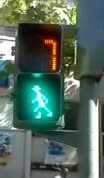Xiaoluren

Xiaoluren (Hsiao-lu-jen; Chinese: 小綠人; pinyin: Xiǎolǜrén; Wade–Giles: Hsiao3-lü4-jen2; "Little Green Man"; officially Chinese: 行人倒數計時顯示, "Pedestrian Countdown Display") is an animated traffic light system in Taiwan.[1] It was first implemented in Taipei City, between Song-shou road and Shi-fu road, in 1999,[2] and came into widespread use around the country within a few years.

The light displays an image of a small green man wearing a hat walking, animated in seven frames at varying speed to suggest relative urgency. It is used in some parts of Spain as well, specially Seville, where it is accompanied by a countdown screen advising pedestrian of time remaining before the light turns. A similar figure as a crossing signal first appeared in East Berlin in 1961 and gained the local nickname Ampelmännchen, but was static rather than animated.
Urban legends
There are a number of urban legends associated with the Xiaoluren in Taiwan, with the most popular version being that the figure will fall down every 20,000 steps,[3] or when the traffic becomes too busy. Other urban legends are that the Xiaoluren would turn sideways or walk upside down from time to time to fool the pedestrians.
Patent conflict
The appearance of the animated image was subject to a dispute over a design patent. Taiwan's Ministry of Communication proclaimed that the device is an aggregative creation, and thus should be public property, but the Kang Shen Technology Company argued that it had applied for a patent for the design early in 1995, which had been rejected by the government for its lack of progressiveness.[4]